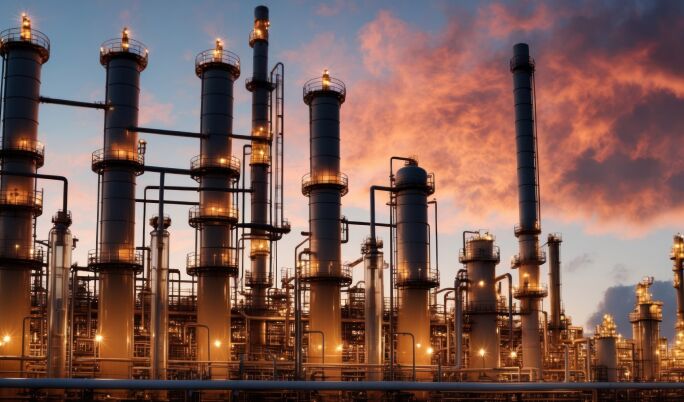Hydrogen sulfide (H2S) is a challenging and hazardous compound encountered in oil and gas operations. It’s a colorless gas with a characteristic “rotten egg” odor, and even in small concentrations, it poses severe health and operational hazards. Prolonged exposure can lead to respiratory distress, while high concentrations can be instantly fatal.
In addition to health risks, H2S is both corrosive and flammable, attacking metals and accelerating the degradation of pipelines, tanks, and equipment.
These risks make it essential for operators to manage and remove H2S efficiently at every stage, from extraction and processing to storage and transport.
The right H2S removal solutions protect worker safety and ensure compliance with U.S. environmental and industrial regulations, including those set by OSHA and the EPA.
As the industry faces increasing scrutiny around emissions and sustainability, effective H2S management has become a defining factor for operational reliability and environmental responsibility.
Why H2S Removal is Critical
1. Safety Risks
Hydrogen sulfide is among the most toxic gases found in oil and gas environments. Exposure to as little as 10 parts per million (ppm) can cause irritation, while levels above 100 ppm can result in loss of consciousness or death.
Beyond toxicity, H2S is flammable and capable of igniting in air at concentrations between 4.3% and 46%.
Lower Explosive Limit (LEL): 4.3% (43,000 ppm) which is the lowest concentration in air that can ignite.
Upper Explosive Limit (UEL): 46% (460,000 ppm) and above this, the mixture is too rich to burn.
For field operators, exposure incidents can have catastrophic consequences. Proper detection, ventilation, and gas removal systems are therefore essential components of every oil and gas operation’s safety protocol.
2. Operational Risks
H2S eats away at infrastructure. Its corrosive nature accelerates damage to carbon steel pipelines, storage tanks, and process equipment. Over time, this leads to leaks, unplanned shutdowns, and expensive repairs.
Moreover, H2S contributes to environmental challenges, including sulfur emissions and contaminated wastewater.
Regulatory compliance with EPA and PHMSA standards requires operators to control both atmospheric and liquid-phase sulfide concentrations. Noncompliance can lead to heavy fines, shutdowns, or loss of permits.
Chemical and Mechanical H2S Removal Solutions
Modern oil and gas facilities rely on a mix of chemical and mechanical methods to manage H2S, depending on concentration levels, process phases, and site constraints.
1. Chemical Scavengers
Chemical scavengers are reactive agents designed to bind with H2S and convert it into non-volatile, stable compounds. These are typically injected into process streams to neutralize H2S on contact.
- Triazine-based scavengers have long been the industry standard due to their fast reaction times and adaptability across gas, crude oil, and water systems. However, they can produce byproducts like dithiazine, which can foul systems and increase maintenance costs.
In recent years, it has become known that triazine-based scavengers are not recommended for crude oil as key ingredients in triazine can cause extremely adverse reactions at refineries.
- Non-triazine and non-amine scavengers are newer alternatives offering improved environmental performance, reduced fouling, and safer handling. These solutions are particularly effective in offshore and midstream applications where space and maintenance access are limited.
Both types are available for liquid-phase and gas-phase applications.
- In gas streams, scavengers are typically used at wellheads or processing plants to “sweeten” natural gas before compression or transport.
- In liquid streams such as crude oil or produced water, they help eliminate odor, corrosion, and emissions during storage or transport.
For instance, a midstream facility in Texas replaced a triazine-based system with a non-triazine scavenger to address fouling issues. The switch reduced downtime by 20% and chemical consumption by 15%, illustrating the operational gains of modern scavenger chemistry.
2. Solid Scavengers
Solid scavengers like iron sponge, zinc oxide, or proprietary media operate through adsorption rather than chemical reaction. They capture H2S from gas streams as the gas flows through a fixed bed of solid material.
The advantages of this system are:
- Simple installation and low maintenance.
- No need for liquid handling or chemical dosing.
- Suitable for remote or low-volume sites.
- Can handle a variety of operating conditions, be it temperature, pressure, daily flow.
Limitations:
- Media replacement is required once saturation occurs. Often this can be engineered for 6 to 12 month intervals.
- Disposal management of spent material. Oftentimes the spent material can be removed and disposed of without special permits.
Despite these drawbacks, solid scavengers remain highly valued for smaller or isolated operations where continuous chemical injection is impractical.
3. Membrane and Mechanical Systems
Membrane separation is a non-chemical alternative for gas-phase H2S removal. These systems use selective permeability to allow methane and other hydrocarbons to pass while trapping and removing H2S.
Benefits include:
- Compact, modular design ideal for offshore installations.
- Lower energy consumption than traditional amine units.
- Continuous, automated operation.
Mechanical systems like bio-oxidation units are also gaining attention. These systems use naturally occurring microorganisms to convert H2S into elemental sulfur and offer a sustainable and chemical-free removal method.
While slower than chemical systems, they’re ideal for steady-state processes where environmental performance is a key priority.
Selecting the Right Solution
Choosing the right H2S removal technology depends on several factors:
- H2S Concentration: Higher concentrations may require multi-stage treatment or continuous chemical dosing.
- Flow Rate: High-throughput systems demand scalable solutions such as membranes or regenerative scavengers.
- Phase of Operation: Gas, crude oil, and wastewater each require different chemistries and operating conditions.
- Environmental and Safety Protocols: Integration with monitoring systems ensures early leak detection and compliance with OSHA and EPA limits.
- Operational Goals: Operators balancing CAPEX and OPEX should consider both immediate efficiency and long-term maintenance costs.
For instance, onshore production facilities may benefit most from non-triazine liquid scavengers, while offshore gas platforms often favor compact membrane or solid scavenger systems for space efficiency.
Benefits of Modern H2S Removal Systems
Today’s advanced H2S removal systems bring more than safety and compliance and offer measurable operational and environmental advantages.
- Improved Safety
Modern scavengers and membrane systems minimize exposure risk and reduce the need for manual handling and maintenance. - Enhanced Regulatory Compliance
Operators stay aligned with EPA air quality and water treatment standards by maintaining low H2S emissions and safe discharge limits. - Operational Efficiency
Non-triazine systems and membranes reduce fouling, lower downtime, and extend equipment life. This translates into better uptime and profitability. - Environmental Responsibility
Eco-friendly scavengers and biological systems cut down on hazardous waste and improve sustainability.
Conclusion
Hydrogen sulfide is an inevitable byproduct of oil and gas production, but it doesn’t have to be an operational liability. The key lies in using certified, high-performance H2S removal solutions designed for the specific demands of your operation.
Operators can achieve safer workplaces, longer-lasting infrastructure, and full environmental compliance by investing in the right combination of technology and process design.
Ultimately, effective H2S removal isn’t just a technical requirement. It’s a strategic advantage that defines the future of responsible, efficient oil and gas production in the United States.





























